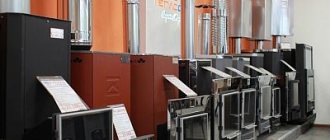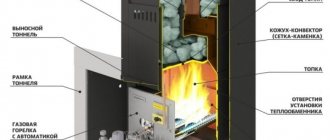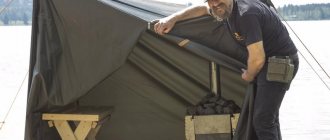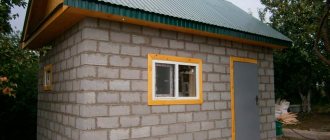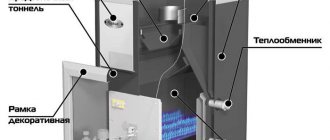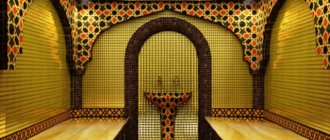One of the serious problems of traditional sauna stoves is their large weight and size. A massive structure requires the use of its own foundation, which, in turn, predetermines the entire construction process. Modern compact designs of stoves make it possible to change the process of arranging a bathhouse, including converting any office space for it.
One of the most effective design options is a cast iron stove, which can quickly and efficiently heat a large sauna. At the same time, it does not have to have large dimensions. Cast iron has the ability to accumulate thermal energy and cools more slowly than steel structures. Let's take a closer look at this type of stove.
5/5 — (1 vote)
Peculiarities
The use of metal stoves in bathhouses quickly became the norm, although their properties differ sharply from those of brick stoves. At the same time, the number of varieties of metal stoves significantly exceeds the number of brick structures.
Among all the options, cast iron stoves stand out, which are considered to be the most effective and even somewhat elite heating options.
From a design point of view, a cast iron stove is no different from other varieties. It consists of a firebox, a chimney, an ash pan and a fuel supply door. However, in addition to wood-burning (solid fuel) stoves, there are gas cast-iron stoves, the design of which consists of a burner and a heat exchanger (one or two).
At the same time, the type of fuel in this case is not of fundamental importance. The main feature is a material whose properties differ significantly from alternative options.
Cast iron is an alloy of iron with carbon and other special additives. This material has special qualities. First of all, it is almost impossible to forge or other types of processing. There are special grades of cast iron, but they are not intended for making stoves.
All parts made from this metal are produced by casting followed by surface treatment. This puts cast iron stoves in a special category - they are almost impossible to make in artisanal conditions.
Selection of stones
When installing a cast iron stove in a bathhouse, you should take care of a set of cobblestones for it. These heating elements are used in almost all types of sauna heating devices.
Some models of cast iron stoves are already sold with the necessary set of stones, but their additional purchase is often required. The weight of the cobblestones is taken from the following calculation: 100 kg per 10 m² of steam room. The average service life is about 2-3 years, after which they need to be replaced.
When choosing stones, it is important to focus on the following points:
- Form. Rounded cobblestones will retain heat longer and cool more slowly than their sharp-angled and multi-faceted counterparts.
- You should not take stones with any damage.
- Cobblestones should be of different sizes: from large to small. Large stones must be placed on the bottom, small ones - on top of them.
- The natural origin of solid rock is also a significant factor determining the selection of these important elements of a device intended for heating a bath.
Advantages and disadvantages
The advantages of cast iron stoves are considered to be:
- the material is resistant to temperature changes and easily withstands all operational loads;
- cast iron does not burn out even during long-term use due to the thick cast walls of the firebox;
- the material is resistant to corrosion, which is the weakest point of steel furnaces;
- a cast iron stove does not need lining;
- external attractiveness. Cast iron castings are distinguished by high surface quality if they are made under appropriate technological conditions;
- cast iron stoves are much safer in terms of fire safety than steel structures;
- compact, light weight, the oven does not take up much space;
- economical fuel consumption;
- When a cast iron stove operates, almost no oxygen is burned in the room.
Disadvantages of cast iron stoves:
- high price;
- difficulty in adjusting temperature;
- There are low-quality stoves on the market, manufactured with violations of technology and quickly losing their working qualities.
Expert opinion
Lovkachev Boris Petrovich
Bath master who knows everything about steaming
The quality of cast iron is a particular problem. Many manufacturers hide the composition of the material, classifying this information as a trade secret. In addition, for a non-specialist, the composition of the metal does not provide useful information, even if it is listed in detail. Therefore, it is useless to consider the properties of the material when purchasing.
However, this moment also has positive qualities - if the seller begins to praise “special cast iron,” then this is most likely an attempt to sell stale goods.
The main advantage of cast iron is its high heat capacity, combined with relatively low thermal conductivity. The efficiency of the material in this regard is 82%, which allows you to efficiently heat a room with one load of fuel.
The walls of the stove are able to release thermal energy much more efficiently, and after the end of the kindling they cool down more slowly and maintain the microclimate longer. This property outweighs all the disadvantages of the material and makes cast iron stoves the most preferable of all metal structures.
Choosing a cast iron stove
The modern market offers a wide variety of devices for heating baths. You can purchase such equipment for a steam room based on individual requests. The choice of a particular model depends on the totality of its distinctive features.
When purchasing the most suitable option, it is important to pay attention to the following factors:
- The external attractiveness of the unit depends on the design solution used by the manufacturer at the production stage. Modern devices equipped with a door with thermal glass allow you to observe the movements of the flames in the firebox.
- A type of fuel , which can be not only firewood and peat briquettes, but also energy sources such as gas and electricity. Electric and gas stoves made of cast iron are easy to use and maintain. Due to the absence of ash, they do not require additional care.
- Material of manufacture. Cast iron can have different markings, which reflect its tensile strength and thickness. These properties significantly affect the service life of the device.
- The efficiency of a wood-burning cast-iron sauna stove depends on the volume of the firebox. This value, as well as the volume of the room required for heating, is indicated in the technical data sheet of the unit. The higher and wider the firebox, the higher the productivity of the model in question.
- Varieties of the device for burning fuel are a conventional device built into the stove and an elongated firebox. It is the second option that is most suitable for baths that have a dressing room or a comfortable rest room.
- Availability of water tank is an additional convenience that helps to purposefully use a cast iron stove not only to generate heat and steam, but also to provide people washing in the bathhouse with hot water. The container for filling and heating the liquid can be located either on the back side of the unit or on top of it - near the chimney.
Many experts and stove masters recommend choosing a cast iron unit as the most suitable option in all respects for arranging a home bath. It is characterized by good performance properties and ease of maintenance.
Varieties
There are different designs of cast iron stoves, which can be divided into groups according to different characteristics.
By fuel type:
solid fuel (wood)
combined (for example, wood-burning with a gas burner)
gas
electric
liquid fuel
Wood-burning cast iron stoves are most often used. They are more familiar and fit better into the general understanding of users about methods of heating a bath.
By type of construction:
completely cast iron
with a cast iron firebox combined with steel elements
By type of heater:
open
As a rule, this is a lattice basket with stones installed immediately above the firebox. This design is most common, as it is economical and effective;
closed heater
It takes longer to heat up, but distributes heat more evenly in the room. In addition, the steam from a closed heater is drier and lighter, which is important for many users.
According to the design of the water tank:
- with a separate tank suspended above the firebox;
- with a tank, which is part of the furnace body.
The first design option is preferable, as it allows you to control the volume of remaining water. The second option is convenient because it does not require the use of additional structures or stands. However, it is difficult to determine how much water is in the tank at the moment; you need to have some habit and experience in operating this model.
NARVI Oy Kota Inari
You can find this model in the “Best stoves for wood-burning saunas” rating. Large, stationary, open-type stove for burning wood. Walls made of thick-walled cast iron, an ash pan, heat-resistant glass and low cost, what could be better?
Characteristics:
- warms the room up to 16 mm³;
- chimney duct with a diameter of 119 mm;
- weight - 94 kg;
- size (H/W/D) - 770x550x550 mm.
Reviews
Ilya, 47 years old
“It’s easy and quick to drown. We needed a firebox for a small large steam room. This is the best choice."
Specifications
Cast iron sauna stoves must perform their functions with maximum efficiency. To do this, their parameters must correspond to the size and configuration of the room and meet the needs of users.
The main characteristics of cast iron stoves are:
- thermal power . This is the main indicator of furnace efficiency. As a rule, models are chosen based on the volume of the room - 1 kW of power per 1 m3. However, for cast iron pipes it is recommended to adhere to increased criteria and select power at the rate of 1.5 kW per 1 m3. This will ensure the durability of the structure;
- material . The best option is gray cast iron, which contains free graphite. This material better tolerates temperature changes;
- thermal capacity . This is an indicator of the ability to accumulate thermal energy and release it after the completion of kindling. Heat-intensive stoves provide more uniform heating of the room;
- additional functions . Furnaces with advanced functionality are preferable to conventional designs.
The set of additional features may vary and relate to the design or general structure of the furnace.
For example, there may be vertical stiffeners, drawers for ash removal, and a private chimney (usually, they are purchased separately). In addition, the stove can be equipped with a clean combustion system, which ensures afterburning of smoke particles and reduces the amount of smoke emitted.
Ermak “20 Mesh standard” (cast iron)
The firebox and body are made of cast iron. This firebox is for those who value aesthetics. There is a mesh for stones, but the stove itself is of the closed type, which is safer. An overhead connection to the chimney duct is provided. Suitable for heating large steam rooms. Easy to buy, always in stock.
Characteristics:
- warms the room up to 20 m²;
- chimney duct with a diameter of 115 mm;
- weight 115 kg;
- size (D/W/H) - 800x540x920 mm.
Reviews
Alexander, 37 years old
“After reading the reviews, I decided to choose this option. Installation took a little time, it doesn't cool down for a long time. My wife still has time to do the laundry.”
How to choose
Choosing a cast iron stove is a responsible task, the correct solution of which determines the quality of bathing procedures. It is necessary to follow several rules, take into account the design features and other parameters of the furnace.
The selection criteria should be:
fuel type Most users prefer wood stoves, but other options can be quite effective and practical;
wall thickness, if specified - metal composition . The thicker the walls, the more uniform the heating and the longer the cooling;
size of the room that this model is capable of heating (indicated in the “performance” column);
size and location of the water tank . Typically the capacity is 20-70 liters, and the location is near the back wall or side of the body, next to the chimney;
door design . Most users prefer doors with heat-resistant glass - they allow you to control the combustion process and look attractive.
In addition to these criteria, the price of the stove is taken into account. Cast iron models are much more expensive than steel ones, so cost is important. Here the choice depends on the user’s own financial capabilities.
Introduction to some models of cast iron stoves
Modern industry produces a large number of such units. However, the following devices are considered the most suitable options for heating steam rooms: Hephaestus PB-03, ATB, Magnum, Vesuvius and Sudarushka.
Bath stoves "Hephaestus"
This equipment is a compact convection-type unit made of heat-resistant cast iron. It has the following parameters: width 500 mm, length 855 mm, height 700 mm. Weight – 205 kg. Power is measured at 12 kW, and efficiency is 87%. For its functioning, 200 kg of stones are required.
The device allows you to heat a room with an area of no more than 25 m². To kindle it, you need to use wood briquettes or firewood. The features of this model are an elongated device for burning fuel and the presence of a flame divider in the combustion chamber. This device is configured for highly efficient heat distribution throughout the body of the structure, due to which the stones heat up much faster. In addition, the Hephaestus cast iron sauna stove is equipped with a decorative forged mesh for laying stones and inserts made of the same material to increase the length of the combustion tunnel.
This unit is supplied disassembled, making it easy to transport. A simple installation of the device is carried out on a previously planned section of the bathhouse. To strengthen the joining of individual elements, a special sealant is used that can withstand high temperatures. This substance, like a steel box for collecting ash, is included in the general package. The sealed door has artistic casting that decorates the interior of the steam room.
The price of a cast iron stove for a Hephaestus bath ranges around 37 thousand rubles.
ATB brand device
ATB bathhouse stoves . Despite the unchanged design, these combustion units do not lose their popularity to this day. The manufacturer of the ATB bath stove uses gray heat-resistant cast iron. Parts of the structure that are not subject to thermal loads (remote firebox, ash pan) are manufactured by welding.
Best models
There are a huge number of cast iron stoves on sale. At the same time, a large number in this case is a disadvantage - making a choice in such conditions is much more difficult, especially for a person with little experience. Therefore, you can focus on a certain rating of stoves that are in maximum demand and preference.
Let's look at the most popular models of cast iron stoves and their characteristics:
Vesuvius LEGEND FORGING 16 (205)
Cast iron stove with a closed heater, designed for installation in rooms with a volume of up to 18 m3. Furnace power - 16 kW. The walls of the firebox are 12 mm thick. The door is equipped with fire-resistant glass. The weight of the heater is 120 kg, the length of the combustion outlet is 120 mm.
- The advantages of the stove are strength, large wall thickness, intense heat transfer, low fuel consumption, and a large heater.
- Cons : heavy weight.
NMK Sibir-18
Cast iron stove designed to heat rooms up to 18 m3. Closed floor model. Power - 16 kW. The length of the combustion tunnel is 200 mm. The door is solid, the weight of the heater is 180 kg.
- Advantages : fast heating, large heater, relatively low price.
- Disadvantages - small combustion chamber offset, lack of visual control over the combustion process.
Ermak 20 Standard mesh
Cast iron stove with a power of 22 kW, designed for installation in a room of up to 20 m3. The furnace has a closed design, the length of the combustion tunnel is 200 mm.
- Advantages : compactness, high heater, safety, clean combustion system.
- Disadvantages - there is no glass in the firebox door, the firebox tunnel is small, the volume of the ash pan is small and requires frequent cleaning.
TMF Tunguska Cast Vitra
One of the cheapest but high-quality models, the demand for which is consistently high. Closed floor model, power 16 kW. Designed to heat a bathhouse with a volume of 18 m3. The length of the combustion tunnel is 200 mm.
- Advantages - a spacious combustion chamber, the casing provides intense convection of hot air, the firebox door is equipped with panoramic glass.
- Disadvantages - inconvenient ash pan, rapid loss of heat after the end of the kindling.
KASTOR Karhu-16 JK
Stove made of high quality cast iron, made in Finland. With a power of 15 kW it can heat a room up to 16 m3. The large ash pan allows you to reduce the frequency of cleaning. The length of the combustion tunnel is 200 mm.
- Advantages : high quality workmanship, attractive appearance, compactness, power.
- Disadvantages : the heater is too small (only 40 kg), high price.
Only the most famous and popular models are listed. The list is dominated by domestically produced stoves. This was done deliberately, since the vast majority of imported models, having almost the same qualities, cost 2-3 times more.
Vesuvius "Sensation 16 Anthracite (270)"
It has a large ash pan; the closed heater can hold up to 60 kg of stones. There is a cooling and self-cleaning system. High quality durable coating. Included in the TOP 5 “Best stoves for Russian baths”.
Characteristics:
- warms the room up to 18 m³;
- chimney duct with a diameter of 120 mm;
- weight - 99 kg;
- size (D/W/H) - 640x410x690 mm.
Reviews
Maxim, 54 years old
“I decided to change the stove; the previous one lasted 15 years. On the advice of a friend, I bought Vesuvius Sensation 16 Anthracite. Easy to maintain, everything is provided. I don’t regret buying it.”
Questions and answers
Let's consider some questions that inexperienced people have in the process of choosing and operating a cast iron stove for a bath:
It is generally accepted that cast iron is brittle. How much can this affect the performance of a cast iron stove?
Indeed, cast iron is fragile. This is a general property of carbon iron alloys. However, in the manufacture of stoves, special grades of cast iron are used, which have greater strength and resistance to mechanical stress. In addition, a sauna stove is almost never exposed to shock, and temperature changes are not dangerous for it.
What is the service life of cast iron stoves?
It is generally accepted that the service life of a cast iron stove is 20 years. This is a considerable period, but it can be increased if you operate the stove correctly and do not expose it to sudden temperature changes or mechanical stress.
If the specifications indicate the composition of the metal, what should you pay attention to?
The composition of cast iron is not often indicated, since many manufacturers hide it. However, if the characteristics indicate the percentage of components, you should ensure that the alloy contains chromium and/or nickel. At the same time, for cast gray cast iron with free graphite, the chromium content can be in the range of 2.2-3.8%, and nickel - about 1%.
How to protect the stove from cold water getting into the hot body?
This is a very undesirable event that can damage the furnace body. There are videos online where they perform experiments on hot cast-iron stoves by pouring cold water on them. In the video, cast iron can withstand this test, but in practice it is strongly not recommended to take such risks. On the contrary, it will be useful to install a steel sheet over the body to cut off possible contact between cold water and hot cast iron.
Do you need your own foundation for a cast iron stove?
According to building regulations, a separate foundation is required for stoves weighing over 700 kg. If the weight of the stove together with the heater and water tank does not exceed this value, the foundation need not be made. However, there are some subtleties here: this rule applies primarily to brick kilns. They need a reliable supporting structure, as they can collapse due to subsidence. There is no such danger for a cast iron stove, although strong support is needed in any case.
What type of fuel is better?
Traditional wood stoves are considered to be the best option. However, this type of stove is in many ways inferior to gas models. They do not require ash removal and do not require constant monitoring and fuel supply. In addition, for many users, electric ovens are the most convenient option. They are safe and do not require a fuel supply or safety precautions associated with gas furnaces.
Best: what do you mean by that?
So, what do we know about cast iron? A brittle metal with a high carbon content, which makes it also very hard. The latter is the reason that it is very difficult to process, which is why manufacturers prefer to cast parts rather than cut them. Casting parts thinner than a centimeter is unprofitable. But why is it better than steel in ovens?
In fact, both cast iron and steel come in different compositions, so a straightforward comparison here is not entirely correct. Let's put it this way: ordinary, unalloyed steel will last less in a furnace than ordinary gray cast iron, if only for the simple reason that the thickness of the furnace wall made of both metals is usually very different: the latter is much thicker.
But
cast iron also oxidizes and burns out , albeit over a longer period of time. Unless his brand is heat resistant. And this is quite rare in purchased stoves and costs money. Heat-resistant steels with the addition of chromium also cost money, and in quality they are quite comparable to suitable brands of cast iron.
At the same time, there is a difference between high-quality steel and cast iron: thinner steel warms up faster and cools down faster. Its heat capacity is low. But cast iron, both because of its thickness and composition, is more prone to heat accumulation (compared to steel, and not to stone, of course). Therefore, the thermal characteristics of such a metal stove will be higher. (And if you also line it with brick, then cast iron will not be inferior to brick in terms of steam quality for a Russian bath!)
In general, having thought about what exactly we mean by the concept of “the best cast iron stoves for a bath,” we reduced it to the following requirements:
- made of heat-resistant cast iron (read more about brands in this article);
- having a closed heater;
- suitable for bricking (no grids for stones).
By the way, also on this topic, look at this article about cast iron stoves with a closed heater.
And as an alternative, please consider brick ones with a closed heater. But all this is relevant only for lovers of the Russian bath (not like the sauna). Everyone else may be quite happy with Vesuvian stoves, so the opinion of which is better depends on the user’s preferences.
Useful video
Quite a long video from which you can glean a lot of useful information, including information not mentioned in our article . We recommend!
You may also be interested in the following information about stoves:
- Types (wood, gas, electric);
- Constructions.
